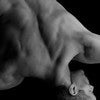Description
About This Video
Transcript
Read Full Transcript
Hi everybody. I'm Tom McCook. I'm here with Christie and Nicole and this session is going to be on how to create balance in your pelvis with ways to release tension, especially in the muscles that tend to get imbalanced and then how to take that into your Polonius or any exercise routine that you do. So the first thing we're going to do is I just want to show you a model of the pelvis of where we're going to put the balls and some of the exercises you have a visual of what that will be. So let me show you what that is. The first one is basically here's the back of the pelvis and we're going to roll out your hamstring attachments first. So if this is the femur head, basically we're going to put the balls right about here at the bottom of the sit bone where there's a lot of muscle and we're going to move our pelvis back and forth. When you're in the sitting position, while you move your feet with that, which will kind of floss the muscles and massage that tissue, the tends to get tight.
The next thing we'll do right after that is massage what's called your para formas. And your para. This muscle is attached to your greater true canter. And interestingly, it goes inside the back of your pelvis and basically forms the upper back wall of your pelvis just above your pelvic floor muscles. So that muscle tends to get imbalanced. If you sit, you sit cross legged, it's gonna have an effect on the positioning of your sake or a mannequin. Just create tension and misalignment of your legs and your spine.
And it has a tendency to do that. You're also have your, your a psychotic nerve runs through this. So when it's tight, you can get what's called Piriformis Syndrome. Okay? So we're gonna do a massage for that, which will feel fabulous and allow you to actually move your lower spine better after. So the first thing we're going to do is we're going to take this away and we're going to take the two Franklin balls. I recommend pause it or else to be soft like this. They don't have to be Franklin balls, but they, they're very useful. Hardballs are gonna hurt a little bit.
So I recommend these as you'll enjoy the process more. So we're going to have a seat and put the balls just below your sit bones at the top of your hamstrings. And now you use your hands just to prop yourself up so you get a little support. Here we go. Now we're ready to roll. Now what are we going to do exactly? So as you lean forward, points your feet and then flex your feet.
Just feel how you're getting that tissue to be massaged. As you floss the muscles in your legs. Now let your breathing be nice and fluid. You're rocking forward and back.
And then you're getting the muscles in the whole back of the leg to slide apart by together and also mobilizing the ankle. Now from there it's staying in the middle. Just go side to side and massage the tissue
So right now we're doing it at the attachments of the hamstrings. Now from there, move it down halfway in the middle of the thigh, so now you're going to be in the belly of the muscle belly of the hip extensors or the hamstring muscles and now you can do again is prop yourself up with your hands a little bit for support and now point and flex again. Now you massaging the muscle in the middle, the meat of it,
You just getting into those muscles at the lower end now and then prop yourself up now. Again, point and flex maybe. No, it doesn't feel super intense. Probably you're getting feedback into those muscles and you're spending a little more time maybe than you would spend
So I'm just gonna show you one more time with the model.
And then as I straighten the leg and roll my pelvis back towards the leg, it's sliding apart. So you'll get to that sliding together and it's sliding bet. So I'm not just moving the leg, I'm moving the pelvis towards and away from the leg. So both ends of the muscle are moving while the ball is massaging. The muscle, so it'll look like this.
So you're going to find your greater tr Kantor go just behind it to the back, like towards your butt and put the ball right behind the greater trocanter. Now come on to your elbow and let the bottom leg be straight. That's it. And your top leg bent for support. Make sure you're not on the bone. You're a little bit behind it. That's not what you're going to do here as you can feel that one, Huh?
Now as you slowly start to bend your down leg, rotate your pelvis towards the ceiling and then as you straighten the leg, turn the pelvis towards the leg and just go back and forth like that. So you're massaging though that muscle from the outer thigh towards the sacrum and let it be really small. So it's really just from the outer back of the outer thigh towards the sacrum.
Then as you straighten it, roll the pelvis towards it. That way the muscle is sliding apart and sliding together and we're breathing. We're having an amazingly good time. Oh my God, our butt is going to be so happy.
It just gives your pelvis and lower back muscles and pelvic floor more range. So take a breath and just bring your awareness to your tailbone. And think of the space between your tail and your pubic villain. Are you pelvic floor muscles? So on the exhale, as you curl the tail towards your knees, lengthen the lower back towards the floor. And now inhale, reach the tail towards your heels and deepen your hip crease. Exhale to curl. And notice as you're doing that, can I keep my neck and shoulders relaxed?
And I'm just going to come up and watch as you guys do.
When's it going to be by your side? We'll pro bring it back in a second. So now just makes it a little more unstable and we're going to include a different plane of motion. So you just went between your tailbone and your belly button. We'll call that 12 and six and now your two hip bones would be three and nine so just keeping the knees straight up and down. Let one hip lift a little towards the ceiling as the other one drops towards the floor. So you're moving in that line from three to nine and go side to side like that and see if you can keep your feet the same and the knees straight up and down and make it pretty small so it's not super big.
That's it. No, she can keep your neck soft and then come back to the middle. Now we're going to include those two and we're going to do what's called a clock. Imagine the clock faces from your, your belly button would be 12 your tailbone would be six. The two hipbones are three and nine so on the exhale, curl towards your belly button to round your lower back towards the floor. And as you that's it rounded the other way. Now hold it there and as you inhale, lengthen towards one hip bone and down to your tail on one side to hit all the numbers on that side of the clock. Then Xcel up on the second side and you use the ball for feedback to roll around the rim of the ball to hit all the numbers, giving a full circle.
So you go all the way down to your tail and you exhale up on the second side. And if it gets a little ratchety or it feels a little tense or you lose where you are, go a little slower. I noticed that you want to keep your neck and shoulders soft throughout that.
And as you get back to the center, take a breath and then reverse and go the other way. You can just visualize your rolling the pelvis back and forth, over and under your leg bones. That's it. Just two more. It feels ratchet ego a little slower. That's it. And then back to the center.
Take a moment now find your other ball and put it back where you had it. So you're now the balls are back and that's next to each other position on each side of the sacrum. Now I'd like you to put your fingers in your lower abdomen or right above your pubic bone and just take a breath. And on the exit, just imagine you're gonna let your fingers sink in a little more and then float up your right leg and then your left leg. But lets your lower legs relax from the knees down. And imagine that you're letting your thigh bones fall into the hip socket.
Now the muscles that are gonna move your legs, your deep hip flexors are deep to your stomach wall. So we want to see if we can avoid bracing a lot in the belly so we can restore some function to the deep hip flexors. Now that one knee without using your lower legs at all, that one day you go towards the floor is the other knee, comes towards your chest and go really slow and just see your thigh bone is rolling in the socket. As the knee comes in, the ball rolls back. As an ego's forward, the ball rolls forward, and as you're doing that, just let your breathing become a little deeper and you want your lower legs to stay relaxed, waxed. So now from your lower legs down, see if you can leave them like that. There you go. That's it. The tendency will be to engage the lower legs. Just feel like it's just a hinge.
That's it. So a lot of the times in polite is what we do is we were taught to brace her abdomen and a lot of times what that can do is inhibit your hip flexors. So we want hip flexors to slide well, that's it. Again, keep relaxing from the knee down. Don't let your legs start to straighten as a knee goes down. Leave it the same bend. There you go. Now go a little faster.
Let the breathing be nice and easeful. The other way that we inhibit our hip flexes is with shoulder and neck tension keeps softening around your neck and shoulders just for two more hours. You guys are just getting warmed up. That's it. Do that for about 10 more seconds.
Now keep the leg relativity relaxed. As you're lowering, visualize, you're using your leg as a weight to east centric. Leigh. Lengthen your deep hip flexor muscles. He Center contraction means that the muscle is contracting. While it's lengthening
Now inhale, reach to the other leg. Straight up long. Exhale, lower towards the floor.
You might notice it's easier to articulate your lower spine. So think of in terms of our function, it's a really good idea to restore function to the deeper hip flexors release tension before we do a lot of superficial abdominal contractions because otherwise we're contracting or abdominal wall on top of tension and everybody sits too much, so their hip flexes, you're probably adaptively short. So this is a great strategy for lower back issues and just for balance and it just good respite somewhere in the day. Now from there we're going to do add a couple more exercises. We'll do stuff for your pelvic floor and your add doctors, your inner thigh muscles. So put the balls back there. Again, bring your knees up in the air and put your hands on the outside of your knees.
That's an just hold it there for a second. I'm just going to show people with the model what I'm talking about now. So your pelvic floor muscles are at the bottom of your pelvis. They attach to the muscles attached your sit, your tail to your pubic bone in the front. From the side, it's like a hammock. So these muscles, when these guys are the way they are, when their knees are closed, you could say that the pelvic floor muscles are relatively closed, but as they open the knees away from each other, the pelvic floor is going to open like a fan.
And on the exhale they're going to close the fan to close the legs. But you're leave your hands out on your thighs so you don't even need to make the range any particular amount. You just want it to be even. So as you inhale, breathe towards the pelvis and let the knees open down the XL, activate the fan at the bottom of the pelvis. Then let the legs follow that
It's the bottom of your spine. So do you want that to be nice and even really great for your lower back? Just two, two more. One more. Now we're going to take that into our resistive stretch resistance, meaning that you're going to contract while the muscle is lengthening.
So take both legs straight up, just a slight knee bend and put your hands inside your thighs with your palms facing out the amount of resistance. Do you want to use it? Probably about 30% of your strength, not not at maximum. Now start to squeeze your legs into your hands. Take a breath on the exhale. Still squeezing what's your arms when now release the resistance to close on the that resist and let the arms win in hell. The close to four more and go for an even quality of resistance all the way through.
One more.
As you press into your heels on the exhale, use your abdominal wall. Now to roll down all running your spine into the math. Let's do that four more times. On the exhale, curl and bridge an l at the top. You use your abdominal wall. Now to attraction your spine towards the back of your heels. Nice. Let's do two more nice and fluid.
Take a breath at the top. You use the abdominal wall. They rolled down. One more nice. Equal pressure into both feet. Exhale the curl. Take a breath, and then sequence down. Now we're going to add a little rotation, so I want you to just feel what it feels like to reach through your left knee so the pelvis rotates to the right like that and then back to the center. Not yet. Just feel that. Just feel that a few times, so you just got it.
Now the knees will stay center as you reached to the knee, but that rotate the pelvis opposed to you rotating the pelvis. Before that, just feel that and see if you can avoid hiking. The hip it off. So you're going to let it rotate this way. That's it. And then back down. This is what your pelvis does on a smaller scale when you walk. So we're going to bring that into your bridge. So take a breath, come back to center. Now reach through your right knee to lift your right hip, a little off the floor on the exhale. Curl up into a bridge on that side of the spine.
Now reach you that the other knee, the left knee to come to the center. Keep reaching through the left knee to drop the right hip and rolled down through the [inaudible] fine, and then back to center. And we'll reverse reach through the knee. Roll up through the spine, reach to the other knee to come to center. Keep reaching through it to lower the hip and roll down on the second side of the spine. And I want you to do two more.
First side, again, curl up. That's it. Reach through the knee to come to the middle. Let the other hip drop and a roll through the spine. And one more rich. Peel up on that one side of the spine. Reach to the low side to level.
Drop the other side and roll down through the spine. Very nice. And just do a little arch curl again. Notice how the backfields and pull your knees in and you're going to rock up to a seated position and come on to all fours now on all fours. Now you're going to add a little compression to your hip joint. So think of all of our joints.
Need some degree of compression and distraction. So compression is actually good for the hip joint. So I want you to float your right knee off the floor. Imagine you're going to let your left thigh sink into the left hip joint. Just imagine it's being absorbed into warm clay, sled it sink.
Now with that free leg that's off the ground and reach it back behind you and you can let the ball, the foot come to the floor. Now we're going to rock on the down knee by rocking the pelvis back and forward and just visualize that your femur head on your weightbearing side is rolling in the socket rolling back as you go back rolling forward as you come forward your head staying nice and line with the spine all the way through. Now come back and take the foot and rotate the leg out. Now you're taking the leg, the down leg into internal rotation. Make sure it's comfortable. Now do the same movement.
Go forward and back. Now you're getting a different angle of that femur head in the socket. Now come back and now rotate it the other way. This is kind of an interesting move as you wrote to the other way with your other knee. Push it forward. That's it, and then slide the other foot back as a little lovely maneuver, wasn't it? That's enough from here or you're going to rock back again and forward an external rotation. Keep pushing the floor down and forward with your arms.
Your chest stays open. Now go back to wherever you can go back. Not too far. Not like you're doing full pigeon and weight shift towards the streets. Set this stretch side and breathe into that. Breathe into that stretch. It's not super hard, but it feels kinda good.
Let's take a couple more breaths there. One more breath. So you're stretching your performance, your hip rotators and your glutes, and then come back and we'll switch sides. So you'll float the other knee a little bit off the floor. Now let the weightbearing leg be absorbed into the hip joint. One thing, it's really good to get those joints set. Get the femur deep into the back of the socket. Improves function.
Now reached the other leg long. Now go forward and back into flexion and extension.
So rotate the foot and I'll leave the knee right? Or leave the knee right on to you. Okay, there you go. No worries. Nice and slow. That's it.
Now rotate the leg towards your other side and with the other Freeney. Push the knee, the foot forward. Here you're bringing it into more external rotation. Slide the other foot back and now go back and forth. So this makes it a little easier on the knee joint than doing full pigeon, but it also, it's getting where you're trying to get.
Now go back, stay back and do a little weight shift towards the hip that's being stretched
Feel the back of your hips widen. Let's see, the femur heads are sliding deep into the back of the socket. Let's do three more
Now stay up and take your theraband and wrap it around the back of your waistline at your belly button level. Now if you can keep your toes tuck down there because this is a stronger position. It's also working on your feet flexibility and this is the band is going to ink in. Add more tone helps stretch the hip flexors, so right around the back of your waist. Hold it there. This changing where you are in relationship to your pelvis and legs. Just push your waistline back into the band and even a little lower Christie like belly button level. There you go. That's it. Just like that.
Now keeping it there. Imagine you get it without stepping around the barn. If possible. You're gonna step one leg straight through as and now as you exhale, contract you back leave. You're not even gonna lift yet. All you're going to do is on the exhale, pull your waistline back into the band as the front knee goes a little forward. Then inhale back four times. That's enough. Think of your waistline's going to go back to call like that way. There you go.
As you need goes four and then you'll feel a bigger stretch.
And again, just two more. That's it.
As you go down and step the leg back and sit back with control. And again, come up, step through, squeeze up, step the leg back could down with control. Step back. We're just going to do one more each side and again, squeeze up, step through, squeeze up, step back, step back and lower. One more. Squeeze up, step through. Squeeze up and release that. Take the band away.
We're going to finish with the squat, so when you squat, take your feet shoulder width apart and turn your toes out slightly. A little wider, a little wide with your feet. Now just feel what it feels like when you've been in these slightly to resist your heels towards one another and with your forefoot. Everyday we turn out a little less. We've got a lot of turnip, and you have to be a little less. Now when you, when you press your heels together, I feel like you're swiping your forefoot outs. You feel the muscles in your back of your hips. Turn on. There you go.
Now we're sitting at them together. Now take your shoulders and retract them a little bit. And as you still start to push the knees apart, reach your sit bones back and descend into a squat. Take it back even more. Sit bones back even more. Nicole, there you go. Now as you exhale, draw the lower belly in and squeeze back up. Now this time as you go down and you get about halfway, feel like you're pulling yourself down into the squat and then squeeze back up two more times.
Exhale, come up. One more. Squeeze back up and there we have it. I hope you enjoyed play with this and let us know how it goes for you. Take care. Thank you.
Comments
Andrew, tennis balls are OK and not quite the same. They're a bit harder and smaller than the 4" balls. It's that's all you have, go with them, otherwise go to Pilates.com to review product and get the 4" green balls.
Ball Placement: Place the balls on each side of the sacrum on the back of the pelvic behind the hip joints. Big thanks to Pilates Anytime!
You need to be a subscriber to post a comment.
Please Log In or Create an Account to start your free trial.

























